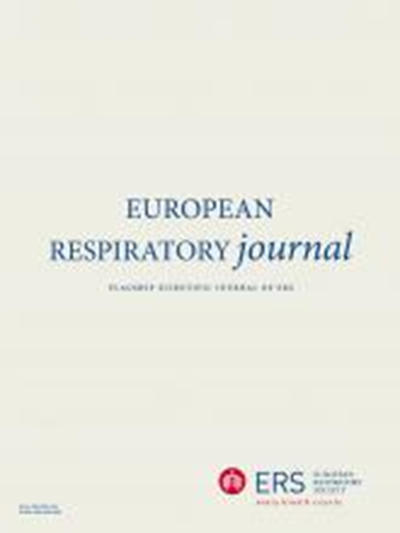不同吸入皮质类固醇和长效支气管扩张剂组合对严重慢性阻塞性肺疾病患者气道微生物组的影响:一项随机试验(MUSIC)
IF 21
1区 医学
Q1 RESPIRATORY SYSTEM
引用次数: 0
摘要
微生物组与COPD的恶化风险、生活质量和死亡率相关。据报道,吸入皮质类固醇(ICS)治疗通过调节宿主防御来改变微生物组。ICS如何改变微生物群以及不同ICS制剂之间的效果是否相同仍存在争议。MUSIC试验的目的是研究常用的ICS疗法是否对COPD患者气道微生物组有不同的影响。方法采用多中心随机对照试验。在他们退出ICS的4周洗脱期后,COPD患者(基线预测FEV1 <50%和/或每年有2次或2次以上加重史)被随机分配到4种治疗方案中的一种(布地奈德/福莫特罗400/12微克,氟替卡松/沙美特罗500微克,氟替卡松/沙美特罗250微克或阿克利地尼/福莫特罗340/12微克,每日2次)。患者随访3个月,每月进行诱导痰、口咽拭子和鼻咽拭子检测细菌载量,并进行16S rRNA测序以表征微生物组。测定痰液和血液中的炎症标志物。主要终点是比较布地奈德/福莫特罗与氟替卡松/沙美特罗500的口咽拭子细菌负荷,痰细菌负荷是关键的次要终点。结果122名受试者开始洗脱期。ICS戒断的耐受性很差,61名参与者在随机分组前退出,其中45名经历了恶化。61例患者随机分组。布地奈德/福莫特罗与氟替卡松/沙美特罗500在口咽细菌负荷方面的初步比较无统计学差异。然而,与布地奈德/福莫特罗相比,氟替卡松/沙美特罗500组在第3个月的痰细菌负荷显著增加。氟替卡松/沙美特罗250组没有出现这种差异。随着时间的推移,微生物组α多样性没有显著差异。两组间不良事件相似。结论氟替卡松/沙美特罗500增加了痰液细菌负荷,但未增加上呼吸道细菌负荷。严重COPD患者难以耐受ICS戒断。本文章由计算机程序翻译,如有差异,请以英文原文为准。
The effect of different inhaled corticosteroid and long-acting bronchodilator combinations on the airway microbiome in patients with severe chronic obstructive pulmonary disease: A randomized trial (MUSIC).
INTRODUCTION
The microbiome is associated with exacerbation risk, quality of life and mortality in COPD. Inhaled corticosteroid (ICS) treatment has been reported to alter the microbiome through modulating host defence. How ICS alters the microbiome and whether effects are equal between different ICS preparations is debated. The aim of the MUSIC trial was to investigate whether commonly used ICS therapies have different effects on the airway microbiome in COPD.
METHODS
Multicentre randomized controlled trial. After a four-week washout period during which they withdrew from ICS, patients with COPD (FEV1 <50% predicted at baseline and/or a history of 2 or more exacerbations per year) were randomized to one of 4 treatments (budesonide/formoterol 400/12 mcg, fluticasone/salmeterol 500 mcg, fluticasone/salmeterol 250 mcg or aclidinium/formoterol 340/12 mcg, twice daily). Patients were followed-up for 3 months with monthly induced sputum, oropharyngeal and nasopharyngeal swabs for bacterial load and 16S rRNA sequencing to characterise the microbiome. Inflammatory markers were measured in sputum and blood. The primary outcome was bacterial load in oropharyngeal swabs comparing budesonide/formoterol versus fluticasone/salmeterol 500, with sputum bacterial load the key secondary endpoint.
RESULTS
122 participants started the washout period. ICS withdrawal was poorly tolerated, 61 participants withdrew before randomization with 45 experiencing an exacerbation. 61 patients were randomized. No statistically significant differences were observed for the primary comparison of budesonide/formoterol versus fluticasone/salmeterol 500 in oropharyngeal bacterial load. There was however a significant increase in sputum bacterial load with fluticasone/salmeterol 500 compared to budesonide/formoterol by month 3. This difference was not seen with fluticasone/salmeterol 250. No significant differences in microbiome alpha diversity were observed over time. Adverse events were similar between the groups.
CONCLUSION
Fluticasone/salmeterol 500 increased sputum but not upper airway bacterial loads. ICS withdrawal was poorly tolerated in severe COPD.
求助全文
通过发布文献求助,成功后即可免费获取论文全文。
去求助
来源期刊

European Respiratory Journal
医学-呼吸系统
CiteScore
27.50
自引率
3.30%
发文量
345
审稿时长
2-4 weeks
期刊介绍:
The European Respiratory Journal (ERJ) is the flagship journal of the European Respiratory Society. It has a current impact factor of 24.9. The journal covers various aspects of adult and paediatric respiratory medicine, including cell biology, epidemiology, immunology, oncology, pathophysiology, imaging, occupational medicine, intensive care, sleep medicine, and thoracic surgery. In addition to original research material, the ERJ publishes editorial commentaries, reviews, short research letters, and correspondence to the editor. The articles are published continuously and collected into 12 monthly issues in two volumes per year.
 求助内容:
求助内容: 应助结果提醒方式:
应助结果提醒方式:


